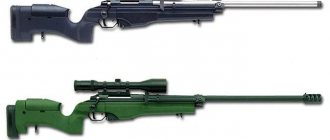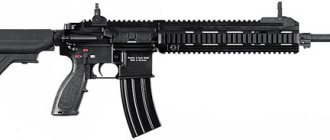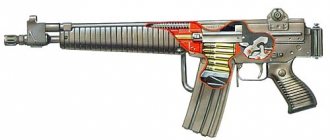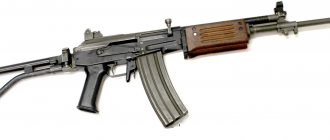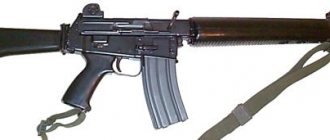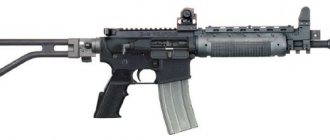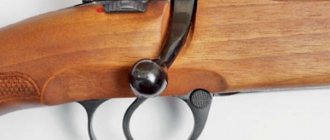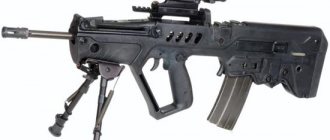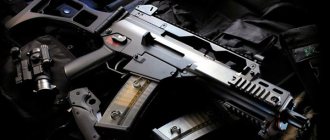The M/60 model is essentially a pre-production model of the T/62 assault rifle, which later became known under the designation Rk. 62. In the design of Rк. 62 used an enlarged trigger guard to enable the infantryman to fire in winter without removing warm gloves.
The Rk 62 is a Soviet AK-47 assault rifle, adapted to the capabilities of Finnish industry and the peculiarities of the local theater of operations.
Not being a member of the Warsaw Pact organization, Finland was nevertheless sometimes forced to act in accordance with the interests of its powerful neighbor, the USSR, despite its neutrality. Therefore, when the Finnish army began choosing new weapons in the 1950s, it was no surprise that the choice of the Soviet AK-47 assault rifle and its cartridge came as a surprise.
Moreover, the Finns held a series of negotiations on the purchase of a license for the production of machine guns and ammunition. As soon as the agreement was signed, Finnish small arms designers made some changes to the design, thus creating the Valmet T/60 rifle, later designated Rk. 60
RK 62 - RK 62
The RK 62
(from Finnish rynnäkkökivääri 62, "assault rifle 62"), officially
the 7.62 RK 62
and commercially
the M62
, is an assault rifle manufactured by Valmet and Sako. It is the standard infantry weapon of the Finnish Defense Forces.
The RK 62 was developed in 1962 and is based on a Polish licensed version of the Soviet AK-47 design. The RK 62 uses the same 7.62×39mm cartridge as the AK-47. Between 1965 and 1994, 350,000 M62 rifles were produced jointly by Valmet and Sako. This is the basis of the IMI Galil, an Israeli-made assault rifle with many similarities. The RK 62 has a three-prong flash suppressor and a slot for a specially designed knife bayonet, which can be used alone as a combat knife.
The RK 95 TP is a more modern, improved variant of the RK 62. One of the most distinctive features of Valmet rifles, including the M62 and all subsequent modifications, is the open compound, three prong flash hider with a bayonet lug on its underside. In addition to suppressing flames, the end can quickly cut through barbed wire by placing the muzzle on a strand of wire and firing.
Aviation units were engaged in the assembly and production under license of the Fouga SM.170 Magister and Hawker Siddeley Hawk training attack aircraft, and Saab Draken fighters. After the closure of the Tampere plant in the 1960s, production was expanded to Kuorevesi.
Own developments are focused on training aircraft for the Finnish Air Force: Valmet Tuuli, Valmet Vihuri, Valmet L-70 Vinka, Valmet L-80 Turbo-Vinha and Valmet L-90TP Redigo, as well as gliders.
Following the privatization of Valmet in 1996, the conglomerate's aircraft production was spun off into the Patria Finavitec division of the Patria defense corporation and focused on assembling the F/A-18 Hornet fighter jets and NHI NH90 helicopters. The plant also participated in the development and production of parts for Airbus, in particular spoilers for the A380.
Valmet Rk 62/76/95, Finland
In the 1950s, the Finnish Armed Forces decide to adopt a new assault rifle. Not wanting to “reinvent the wheel,” the Finns decide to take an existing model and modify it to suit their needs. For many reasons, the choice was made in favor of the “big neighbor’s assault rifle,” that is, the Soviet AK (AK-47). The Finns purchased a license for its production, and in 1960, Valmet presented the Rk.60 assault rifle, which was a modification of the AK, for army testing. Being an exact copy of the AK in terms of all mechanisms, the Rk.60 was quite noticeably different from the AK in appearance. It had a metal awkward tubular butt, a plastic handle and forend that did not cover the gas tube. There was no trigger guard. The Kalashnikov sight was replaced with a new one - the front sight was moved to the gas chamber, and the diopter rear sight was moved to the receiver cover. A slotted flame arrester with a bayonet mount was installed on the barrel. In 1962, after minor modifications based on test results, the new machine gun was put into service under the designation Rk.62. Modifications included a new plastic handguard and a rebuild of the trigger guard. To this day, the Rk.62 is in service with the Finnish Armed Forces. Continuing the development of the Rk.62, Valmet creates various modifications of the machine gun both for the army and for the civilian market and export sales. Export modifications could have the original caliber 7.62x39mm or 5.56mm NATO, be self-loading or with automatic fire capability. In addition, based on the original design, a Valmet 78 light machine gun chambered for the 7.62x51mm NATO cartridge was created, and on its basis an export self-loading carbine was created. Of the army models, the most interesting are the Rk.76 and Rk.95TR models. The Rk.76 model, adopted along with the Rk.62 in 1976, is distinguished mainly by a stamped receiver (similar to the AKM), as well as a new handguard that partially covered the gas tube. The weight of the Rk.76 compared to the Rk.62 was significantly reduced, but later the Finns decided to return to a more expensive and heavier milled receiver, which was more durable and better able to absorb heat during intense shooting. The Rk.76 was produced with four stock options: fixed wooden (Rk.76W), fixed plastic (Rk.76P), fixed tubular (Rk.76T) and side-folding tubular (Rk.76TP). The Rk.95TP model is the latest model adopted for service in Finland. Rk.95TP has a milled receiver. The buttstock is folding to the right, made like the Israeli Galil assault rifle. A new flash suppressor is installed on the barrel, and the plastic forend is slightly enlarged. The cocking handle is bent upward approximately 45 degrees, allowing you to cock the weapon with your left hand. The trigger guard has been enlarged for greater ease of shooting with winter gloves. The self-loading version of the Rk.95 is produced for the civilian market and is used for training and practical shooting (according to IPSC rules). It should be noted that in connection with the merger of Valmet and Sako under the name Sako, commercial samples are designated as Sako M95. All military modifications from Rk.62 to Rk.95TP can be equipped with Finnish-developed Reflex devices to reduce the sound of a shot (silencers). In general, all members of the Valmet / Sako family of assault rifles are high quality weapons, fully adapted to the harsh conditions of Northern Europe. MAIN TECHNICAL CHARACTERISTICS OF VALMET RK.62
Caliber 7.62x39mm or 5.56x45mm NATO
Length 914 mm
Barrel length 420 mm
Weight 4.3 kg without magazine (3.5 kg Rk.76 with stamped receiver)
Magazine capacity 30 rounds
Rate of fire -
Device
AKM consists of the following main parts and mechanisms:
- barrel with receiver, sighting device and butt;
- compensator (in models from the 1960s) [2] ;
- receiver cover;
- bolt carrier with gas piston;
- gate;
- return mechanism;
- gas tube with receiver lining;
- trigger mechanism;
- forend;
- shop;
- bayonet knife.
The AKM kit includes: a cleaning rod and a pencil case with accessories (wiping, brush, screwdriver, drift, pin, oil can), a belt and a bag for carrying magazines. The AKMS kit additionally includes a case for the machine gun with a pocket for the magazine.
Sighting device
The AKM sighting device consists of a front sight and a sight, which in turn consists of a sight block, a leaf spring, a sighting bar and a clamp. On the sighting bar there is a scale with divisions from 1 to 10 (firing range in hundreds of meters) and the letter “P” (permanent sight setting, corresponding to sight 3).
Late-release assault rifles are equipped with devices for shooting at night (self-luminous attachment), consisting of a folding rear sight with a wide slot (installed on the sighting bar) and a wide front sight (attached to the front sight of the weapon from above), on which luminous dots are applied. This device does not separate during operation - when shooting during the day, the front sight and rear sight are folded down without interfering with the use of standard sighting devices.
Design[edit]
RK 62 field has been cleared.
The RK 62 is considered a high-quality variant of the AK-47. The biggest improvement, besides the metallurgical quality of the receiver and the overall quality of the barrel, was the sights - most AK variants have the rear sight mounted on top of the gas piston housing above the receiver. The Rk62 has a rear sight mounted on the rear of the receiver with tritium illuminated night sights. The sight radius is doubled, which improves shooting accuracy along with the hammer forged CM match barrel. Aperture rear sight on a sliding tangent with a folding tritium night sight, front closed post, sight radius 470 mm. [5]
This is especially noticeable in its accuracy, as it can often reach less than one arcminute. [ citation needed
] The rifle uses a diopter sight that flips to reveal an open tritium enhanced night sight. The front sight also has a night mode. The gas tube is connected to the front trunnion and is a single diameter tube, unlike the AK/AKM tube which has a star-shaped cross-section to guide the piston, allowing gases to escape behind it. The gas piston has a toothed ring on the rod behind the piston head. The diameter of the ring matches the diameter of the tube and it acts as a guide inside the gas tube, and the notches in the ring allow excess gases to be vented behind the piston head/guide. This system reduces the number of parts and simplifies production and assembly/disassembly. This design entered the IMI Galil. A port in the shoulder pad allows you to store items (such as a cleaning kit) in the tubular stock.
All RK variants are designed to withstand the extreme environmental conditions of Northern Europe.
Improved options
After the merger and Sako, a small design team developed modernized variants of the Rk. 62, Rk. 76 and Rk. 95TP. The first was distinguished by a stamped receiver instead of a milled one, which helped reduce weight, as well as the ability to install four types of stocks (permanent wooden, plastic and tubular, as well as folding tubular in the Rk. 76W, Rk. 76P, Rk. 76T, Rk. 76TP variants, respectively ). The Sako Rk model is also known. 75 with a machined receiver, but with a folding frame stock, a new trigger guard and an improved flash suppressor.
Based on AK-47
The fact that the Finnish model is descended from the AK-47 can be easily determined by the appearance of the Rk. 60, but some new solutions were applied in its design. In Rk. 60, no wood is used in manufacturing; the wooden parts of the AK-47 were replaced with plastic and metal. Thus, the tubular stock Rk. 60 is easier to manufacture and also more durable and suitable for storing cleaning supplies.
The pistol grip and fore-end are molded from hard plastic, while the trigger guard allows shooting with gloves. Other differences from the AK-47 include a modified design of sights, a flash suppressor with three slots, a Finnish-style bayonet and, accordingly, a different mount. The internal mechanisms remained unchanged, but their manufacturing technology was slightly changed. The sector magazine and its slot remain unchanged to allow the use of AK-47 magazines.
Later, the modification t/62 or Rk appeared. 62, which is not too different from Rk. 60, with the exception of additional cooling holes in the forend and installation of the trigger guard. An export version of 5.56 mm caliber was also produced.
Ammo [edit | edit code]
The AKM is fired using cartridges of the 1943 model (7.62×39 mm) with the following types of bullets [1]:
- an ordinary one with a steel core
is designed to defeat enemy personnel located openly or behind obstacles pierced by a bullet. The shell is steel covered with tombac, the core is steel, and there is a lead jacket between the shell and the core. Has no distinctive coloring. - The tracer
is designed for target designation and fire adjustment at distances of up to 800 m, as well as defeating enemy personnel. The core consists of an alloy of lead and antimony, behind which there is a cup with a pressed tracer compound. The color of the bullet is green. - armor-piercing incendiary
is designed to ignite flammable liquids, as well as defeat manpower located behind lightly armored shelters at ranges of up to 300 m. The shell is with a tombak tip, the core is steel with a lead jacket. Behind the core in a lead pan there is an incendiary composition. The color of the head part is black with a red belt.
Aviation units were engaged in the assembly and production under license of the Fouga SM.170 Magister and Hawker Siddeley Hawk training attack aircraft, and Saab Draken fighters. After the closure of the Tampere plant in the 1960s, production was expanded to Kuorevesi.
Own developments are focused on training aircraft for the Finnish Air Force: Valmet Tuuli, Valmet Vihuri, Valmet L-70 Vinka, Valmet L-80 Turbo-Vinha and Valmet L-90TP Redigo, as well as gliders.
Following the privatization of Valmet in 1996, the conglomerate's aircraft production was spun off into the Patria Finavitec division of the Patria defense corporation and focused on assembling the F/A-18 Hornet fighter jets and NHI NH90 helicopters. The plant also participated in the development and production of parts for Airbus, in particular spoilers for the A380.
Development of the Finnish assault rifle began in the 1950s. Various foreign designs were considered, of which the most significant was the Soviet AK-47. The first version was called RK 60
.
The RK 62 was produced in 1960 at the Valmet plant in Turul and internally was almost a copy of the AK-47. It featured a metal stock, plastic fore-end and pistol grip, but no trigger guard (it was hoped that this would make the weapon easier to fire in the cold Finnish winter when soldiers wore warm mittens). The very first prototypes, closely modeled after the license-produced AK, were tinted birch wood. After testing by the armed forces, the RK 60 was slightly modified (the trigger guard was restored) and accepted into service as the 7.62 RK 62.
Links[edit]
- Salo Pauli (2007). Rynnäkkökivääri 7.62×39. (Assault rifle 7.62x39) (2nd ed.). ISBN 978-952-92-1328-3.
Notes
- "Archive copy" (PDF). Archived from the original (PDF) on November 29, 2014. Retrieved November 16, 2014. CS1 maint: archived copy as title (link) FDF Light Weapons Guide 2004
- "Valmet Home". valmetweapons
. Retrieved October 25, 2014. - "Archival copy". Archived from the original on March 3, 2016. Retrieved November 12, 2015.CS1 maint: archived copy as title (link)
- "Suomalainen rynnäkkökivääri uudistuu radikaalisti -" superrynkyn "hankinnasta luovuttu". Retrieved August 6, 2015.
- [1] [ broken link
] - ^ B s d e g h i J k l m Palokangas, Markku (1991). Sotilaskäsiaseet Suomessa 1918-1988: Suomen maanpuolustuksen ja sotien kevyt kiväärikaliiperinen aseistus itssenäisyyden 70 vuoden aikana. 2. osa, Suomalaiset aseet
(in Finnish). Suomen asehistoriallinen seura. ISBN 951-25-0518-5. - Salpa 07-yhtymäharjoitus — Uutiset JA artikkelit Archived April 25, 2008 in the Wayback Machine
- Kuvia and videota
- ^ abc "Finnish RK62M Sako/Valmet rifle - a closer look at the long-awaited upgrade -". July 25, 2019.
- ^ ab "Finland introduces new updated RK62M -". May 2019.
- ^ ab "Nickel plated Valmet M76". valmet.org
. February 4, 2008, archived from the original on August 5, 2019. Retrieved August 5, 2022. - ^ ab "Valmet RK cal .222 Remington". irc-galleria.net
(in Finnish). November 10, 2013. Archived from the original on August 5, 2019. Retrieved August 5, 2022. - "Modern Firearms". October 27, 2010. Retrieved October 25, 2014.
- Antti Varri. "Konetuliaseet ja automaattipistoolit". Archived from the original on November 6, 2007. Retrieved September 2, 2007.
- https://www.americanrifleman.org/articles/2017/12/28/galil-ace-iwi-brings-the-ak-into-the-modern-era/ Galil ACE: IWI brings AK into the modern era. by Jeremiah Knupp. December 28, 2022
- "Estonian peacekeeper in Lebanon with Finnish RK62".
- "Upgraded versions of the assault rifle for use in brigade-level units - Article - Finnish Army".
- ^ ab Jenzen-Jones, NR; McCollum, Ian (April 2022). Small Arms Review (ed.). Internet Traffic: Analysis of the Online Trade in Small Arms and Light Weapons in Libya (PDF). Working Paper No. 26, pp. 82–83.
Improved options
After the merger and Sako, a small design team developed modernized variants of the Rk. 62, Rk. 76 and Rk. 95TP. The first was distinguished by a stamped receiver instead of a milled one, which helped reduce weight, as well as the ability to install four types of stocks (permanent wooden, plastic and tubular, as well as folding tubular in the Rk. 76W, Rk. 76P, Rk. 76T, Rk. 76TP variants, respectively ). The Sako Rk model is also known. 75 with a machined receiver, but with a folding frame stock, a new trigger guard and an improved flash suppressor.
Aviation units were engaged in the assembly and production under license of the Fouga SM.170 Magister and Hawker Siddeley Hawk training attack aircraft, and Saab Draken fighters. After the closure of the Tampere plant in the 1960s, production was expanded to Kuorevesi.
Own developments are focused on training aircraft for the Finnish Air Force: Valmet Tuuli, Valmet Vihuri, Valmet L-70 Vinka, Valmet L-80 Turbo-Vinha and Valmet L-90TP Redigo, as well as gliders.
Following the privatization of Valmet in 1996, the conglomerate's aircraft production was spun off into the Patria Finavitec division of the Patria defense corporation and focused on assembling the F/A-18 Hornet fighter jets and NHI NH90 helicopters. The plant also participated in the development and production of parts for Airbus, in particular spoilers for the A380.
In the vastness of Palestine
The FN FAL rifles that Israeli soldiers were armed with during the Six-Day War did not perform well - their automation turned out to be too sensitive to sand and dust, which abound in the Middle East.
In 1969, a competition was held for a new assault rifle for the army, in which designers Uziel Gal (author of the Uzi submachine gun) and Israel Galili participated. The latter emerged victorious, offering a slightly optimized Valmet Rk.62. The Finns sold the documentation and equipment for the production of the machine gun to the sworn friends of the USSR, and, according to rumors, the first batches of Galil were even made on the basis of Finnish receivers.
UN peacekeeper with Galil
Photo: MONUSCO Photos / Flickr
Galil's innovations include a barrel extended to 50 centimeters, a caliber of 5.56 millimeters (subsequently, samples were produced with barrels of different lengths chambered for 7.62x39, 7.62x51 NATO cartridges), a slotted flash hider, like the M16, a folding frame stock, borrowed from one of the modifications of the FN FAL, and in general in the design of the early Galils one can read the influence of the Belgian rifle. Another innovation was a folding bipod with a bottle opener, a carrying handle and a special Israeli feature - an elongated and upward-curved bolt handle, which allowed you to pull the bolt with your left hand without tying your hands in a knot.
The weapon turned out to be successful, but did not last long in the army, giving way to the American M16 and CAR15 (a shortened version of the M16). Most often they say that Galil was too heavy. It’s true, a Kalashnikov-based assault rifle weighed about four and a half kilograms, and the M16 weighed about three. But it's not only that. During the Arab-Israeli wars, the Americans sold significant quantities of their rifles to the Israelis at very low prices. And the Galil with its milled receiver was quite expensive to produce, so they began to be produced only as a reserve if for some reason the supply of M16s stopped. By the way, this replacement did not at all please the Israeli military themselves, who liked reliable and proven weapons.
Galil ACE 32 chambered for 7.62x39 mm
Photo:
Galil was also actively exported, and licenses for its production were sold to other countries. The Israelis even managed to oust the USSR, and subsequently Russia, in the traditional Kalashnikov regions, such as Latin America, Africa and Asia. And even in the post-Soviet space, for example in Estonia (in total, Galil is in service with more than two dozen countries). You can recall the demarche of Vietnam in January 2014, when it was announced that the IWI division had launched a plant here for the production of Galil ACE 31 and Galil ACE 32. These are the latest versions of the Israeli assault rifle with noticeably improved ergonomics and controls - telescopic stock, automatic bolt stop, handle The shutter is located on the left side, and the slot for it is closed by a special movable curtain. It is possible to install additional equipment (collimator sights, flashlights, etc.).
At one time, among Russian weapon enthusiasts, the Galil ACE was called the perfect Kalash. Today, the AK Alfa assault rifle from another Israeli company, SAA, is vying for this role.
It is assumed that the Galil ACE 31 and Galil ACE 32 will gradually replace the Kalashnikov assault rifles in service with the Vietnamese army.
